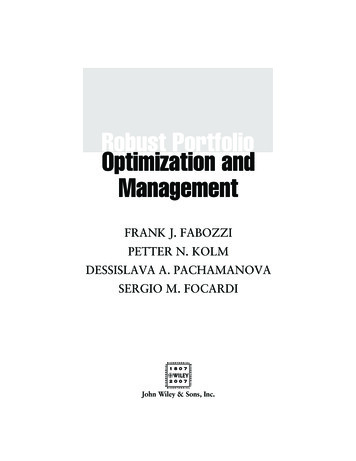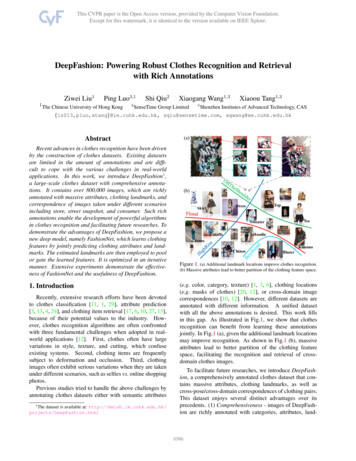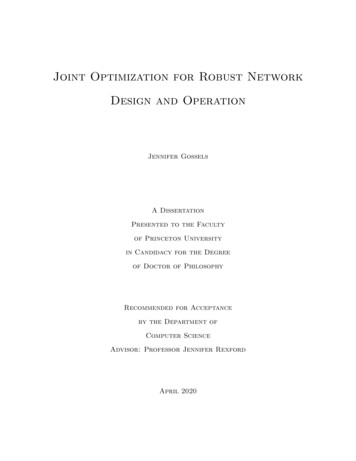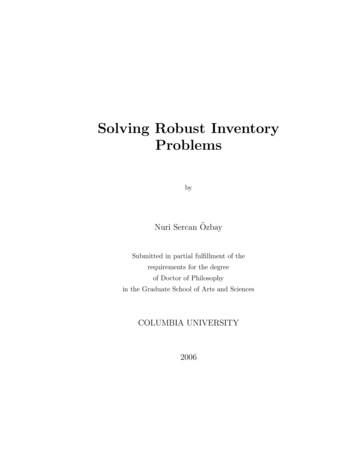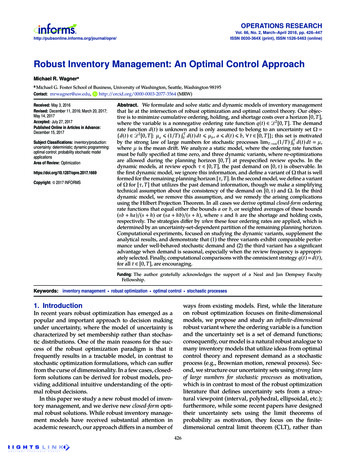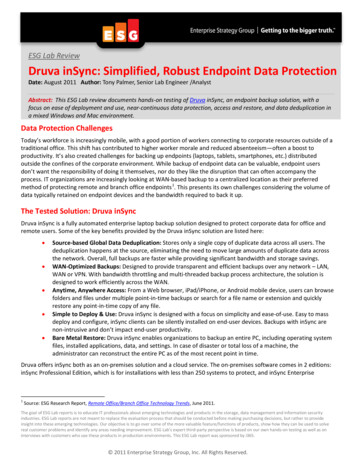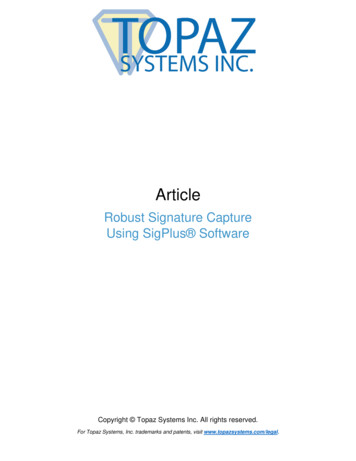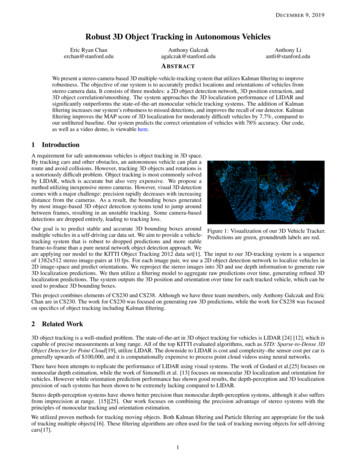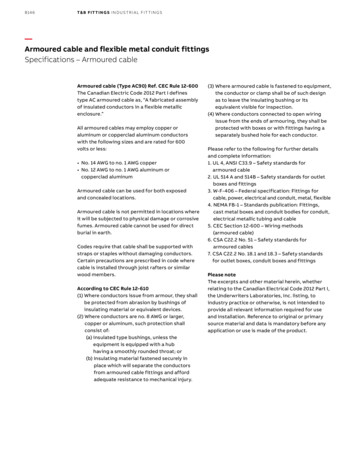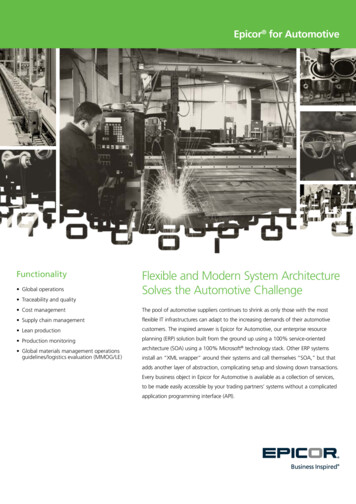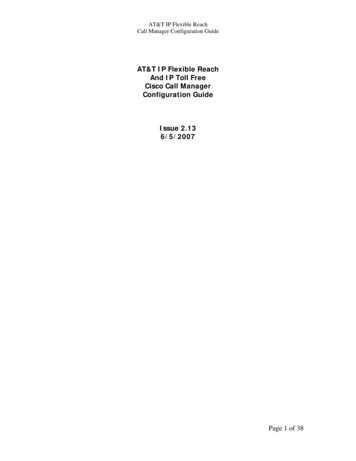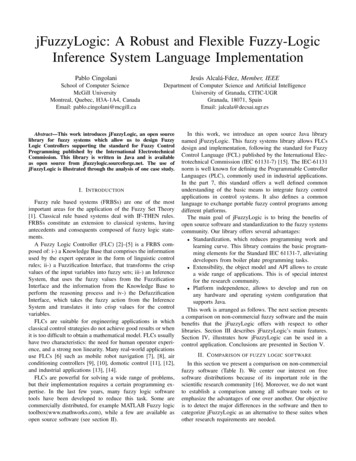
Transcription
jFuzzyLogic: A Robust and Flexible Fuzzy-LogicInference System Language ImplementationPablo CingolaniJesús Alcalá-Fdez, Member, IEEESchool of Computer ScienceMcGill UniversityMontreal, Quebec, H3A-1A4, CanadaEmail: pablo.cingolani@mcgill.caDepartment of Computer Science and Artificial IntelligenceUniversity of Granada, CITIC-UGRGranada, 18071, SpainEmail: jalcala@decsai.ugr.esAbstract—This work introduces jFuzzyLogic, an open sourcelibrary for fuzzy systems which allow us to design FuzzyLogic Controllers supporting the standard for Fuzzy ControlProgramming published by the International ElectrotechnicalCommission. This library is written in Java and is availableas open source from jfuzzylogic.sourceforge.net. The use ofjFuzzyLogic is illustrated through the analysis of one case study.I. I NTRODUCTIONFuzzy rule based systems (FRBSs) are one of the mostimportant areas for the application of the Fuzzy Set Theory[1]. Classical rule based systems deal with IF-THEN rules.FRBSs constitute an extension to classical systems, havingantecedents and consequents composed of fuzzy logic statements.A Fuzzy Logic Controller (FLC) [2]–[5] is a FRBS composed of: i-) a Knowledge Base that comprises the informationused by the expert operator in the form of linguistic controlrules; ii-) a Fuzzification Interface, that transforms the crispvalues of the input variables into fuzzy sets; iii-) an InferenceSystem, that uses the fuzzy values from the FuzzificationInterface and the information from the Knowledge Base toperform the reasoning process and iv-) the DefuzzificationInterface, which takes the fuzzy action from the InferenceSystem and translates it into crisp values for the controlvariables.FLCs are suitable for engineering applications in whichclassical control strategies do not achieve good results or whenit is too difficult to obtain a mathematical model. FLCs usuallyhave two characteristics: the need for human operator experience, and a strong non linearity. Many real-world applicationsuse FLCs [6] such as mobile robot navigation [7], [8], airconditioning controllers [9], [10], domotic control [11], [12],and industrial applications [13], [14].FLCs are powerful for solving a wide range of problems,but their implementation requires a certain programming expertise. In the last few years, many fuzzy logic softwaretools have been developed to reduce this task. Some arecommercially distributed, for example MATLAB Fuzzy logictoolbox(www.mathworks.com), while a few are available asopen source software (see section II).In this work, we introduce an open source Java librarynamed jFuzzyLogic. This fuzzy systems library allows FLCsdesign and implementation, following the standard for FuzzyControl Language (FCL) published by the International Electrotechnical Commission (IEC 61131-7) [15]. The IEC-61131norm is well known for defining the Programmable ControllerLanguages (PLC), commonly used in industrial applications.In the part 7, this standard offers a well defined commonunderstanding of the basic means to integrate fuzzy controlapplications in control systems. It also defines a commonlanguage to exchange portable fuzzy control programs amongdifferent platforms.The main goal of jFuzzyLogic is to bring the benefits ofopen source software and standardization to the fuzzy systemscommunity. Our library offers several advantages: Standardization, which reduces programming work andlearning curve. This library contains the basic programming elements for the Standard IEC 61131-7, alleviatingdevelopers from boiler plate programming tasks. Extensibility, the object model and API allows to createa wide range of applications. This is of special interestfor the research community. Platform independence, allows to develop and run onany hardware and operating system configuration thatsupports Java.This work is arranged as follows. The next section presentsa comparison on non-commercial fuzzy software and the mainbenefits that the jFuzzyLogic offers with respect to otherlibraries. Section III describes jFuzzyLogic’s main features.Section IV, illustrates how jFuzzyLogic can be used in acontrol application. Conclusions are presented in Section V.II. C OMPARISON OF FUZZY LOGIC SOFTWAREIn this section we present a comparison on non-commercialfuzzy software (Table I). We center our interest on freesoftware distributions because of its important role in thescientific research community [16]. Moreover, we do not wantto establish a comparison among all software tools or toemphasize the advantages of one over another. Our objectiveis to detect the major differences in the software and then tocategorize jFuzzyLogic as an alternative to these suites whenother research requirements are needed.
We analyze twenty five packages (including jFuzzyLogic),mostly from SourceForge or Google-Code, which are considered to be amongst the most respectable software repositories.The packages are analyzed in the following categories: FCL support. Only four packages ( 17%) claim to support IEC 61131-7 specification. Notably two of them arebased on jFuzzyLogic. Only two packages that supportFCL are not based on our software. Unfortunately neitherof them seem to be maintained by their developers anymore. Furthermore, one of them has some code fromjFuzzyLogic.Programming language. This is an indicator of codeportability. There languages of choice were mainly Javaand C /C (column Lang.). Java being platform independent has the advantage of portability. C has anadvantage in speed, but also allows easier integration inindustrial controllers.Functionality. Seven packages ( 29%) were made forspecific purposes, marked as ‘specific’ (column Notes,Table I). Specific code usually has limited functionality,but it is simpler and has a faster learning curve for theuser.Membership functions. This is an indicator of how comprehensive and flexible the package is. Specific packagesinclude only one membership function (typically trapezoid) and/or one defuzzification method (data not shown).In some cases, arbitrary combinations of membershipfunctions are possible. These packages are marked withasterisk. For example, ‘M N ’ means that the softwaresupports M membership functions plus another N whichcan be arbitrarily combined.Latest release. In eight cases ( 33%) there were noreleased files for the last three years or more (see Rel.column in the Table I). This may indicate that the packageis no longer maintained, and in some cases the web siteexplicitly mentions this.Code availability and usability. Five of the packages ( 21%) had no files available, either because the projectwas no longer maintained or because the project neverreleased any files at all. Whenever the original sites weredown, we tried to retrieve the projects from alternativemirrors. In three cases ( 13%) the packages did notcompile. We performed minimal testing by just followingthe instructions, if available, and make no effort to correctany compilation problems.In summary, only eight of the software packages ( 33%)seemed to be maintained, compiled correctly, and had extensive functionality. Only two of them are capable of parsingFCL (IEC-61131-7) files and both are based on jFuzzyLogic.III. JF UZZY L OGICFuzzy Control Language is an industry standard specification released by the International Electrotechnical Commission(IEC) as part of the Programmable Controller Languages(PLC) defined in the IEC-61131 specification.The specification defines six programming languages: Instruction list (IL), Structured text (ST), Ladder diagram (LD),Function block diagram (FBD), Sequential function chart(SFC), and Fuzzy Control Language (FCL). While IL, ST,and FCL are text based languages, LD, FBD and SFC aregraphic based languages.Instruction list is similar to assembly language: one instruction per line, low level and low expression commands.Structured text, as the name suggests, intends to be morestructured and it is very easy to learn and understand foranyone with a modest experience in programming. The focusof this work is FCL, which is oriented to fuzzy logic basedcontrol systems and its syntax is similar to ST.A. IEC Language conceptsAll IEC-61131 languages are modular. The basic module iscalled Programmable Organization Unit (POU) and includesPrograms, Functions or Function Blocks. A system is usuallycomposed of many POUs, and each of these POUs canbe programmed in a different language. For instance, in asystem consisting of two functions and one function block(three POUs), one function may be programed in LD, anotherfunction in IL and the function block may be programmed inST. The norm defines all common data types (e.g. BOOL,REAL, INT, ARRAY, STRUCT, etc.) as well as ways tointerconnect POUs, assign process execution priorities, processtimers, CPU resource assignment, etc.The concepts of a Program and Functions are quite intuitive.Programs are simple set of statements and variables. Functionsare calculations that can return only one value and are notsupposed to have state variables.A Function Block resembles a very primitive object. Itcan have multiple input and multiple output variables, can beenabled by an external signal, and can have local variables.Unlike an object, a function block only has one executionblock (i.e. there are no methods). The underlying idea for theselimitations is that you should be able to implement programsusing either text-based or graphic-based languages. Havingonly one execution block, allows to easily control executionwhen using graphic-based language to interconnect POUs.At first glance FCL is similar to ST. However, there aresome very important differences. FCL uses exclusively a newPOU type: Fuzzy Inference System (FIS) which is a specialcase of a Function Block. All fuzzy language definitionsshould be within a FIS. Since a fuzzy system is inherentlyparallel, there is no concept of execution order, therefore thereare no statements. For instance, there is no way to createthe typical “Hello world” example since there is no printstatement. A simple example of a FIS using FCL is shownin Table II, this FCL code calculates the tip in a restaurant(the equivalent of a “Hello world” program in fuzzy systems).Fig. 1 shows the membership functions.Table III shows the corresponding Java code to run the FCLcode shown in Table II.
TABLE IC OMPARISSON ON OPEN FUZZY LOGIC SOFTWARE PACKAGES . C OLUMNS DESCRIBE : P ROJECT NAME (NAME ), IEC 61131-7 LANGUAGE SUPPORT (IEC),LATEST RELEASE YEAR (R EL .), MAIN PROGRAMMING LANGUAGE (L ANG .), SHORT DESCRIPTION FORM WEBSITE (D ESCRIPTION ), NUMBER OFMEMBERSHIP FUNCTIONS SUPPORTED (MF) AND F UNCTIONALITY ( NOTES ). NAME : PACKAGE IS MAINTAINED , COMPILES CORRECTLY, AND HASEXTENSIVE FFLLFispro FLUtEFOOLFRBSfunzyFuzzy Logic Tools FuzzyBlackBoxFuzzyClipsFuzzyJ ToolKitFuzzyPLC GUAJE javafuzzylogicctrltoolJFCMJFuzzinatorjFuzzyLogic jFuzzyQt libailibFuzzyEnginenxtfuzzylogicOctave FLT XFuzzy3 00620112011201120102011201120102010201020112003C C C#C C /JavaC#CC JavaC C/LispJavaJavaJavaJavaJavaJavaJavaC JavaC JavaOctaveJavaFig. 1.DescriptionMFFramework for complex AI agents.Fuzzy logic expert system.NET library for fuzzy logicOptimized for speed critical applications.Fuzzy inference design and optimizationA generic Fuzzy Logic EngineFuzzy engineFuzzy Rule-Based SystemsFuzzy Logic reasoningFramework fuzzy control systems,Implementing fuzzy logicFuzzy logic extension of CLIPSFuzzy logic extension of JESSFuzzy controller for PLC Siemens s226Development environmentFramework for fuzzy rulesFuzzy Cognitive Maps (FCM)Type-1 Fuzzy logic engineFCL and Fuzzy logic APIjFuzzyLogic cloneAI library, implements some fuzzy logicFuzzy Engine for JavaFor Lego Mindstorms NXTFuzzy logic for ToolkitDevelopment environmentMembership functions for tipper example.B. jFuzzyLogic ImplementationjFuzzyLogic is fully implemented in Java, thus the packageis platform independent. ANTLR [17] was used to generateJava code for a lexer and parser based on our FCL grammardefinition. This generated parser uses a left to right leftmostderivation recursive strategy, formally know as “LL(*)”.Using the lexer and parser created by ANTLR we are able toparse FCL files by creating an Abstract Syntax Tree (AST), awell known structure in compiler design. The AST is convertedinto an Interpreter Syntax Tree (IST), which is capable of421461512 123 2 1511 14 211 14 8311116NotesDoes not compileSpecificDoes not compileBeta versionDoes not compileSpecificSpecificNo files releasedNo longer maintainedNo longer maintainedUses jFuzzyLogicUses FisProNo files releasedSpecificSpecificThis paperSpecificSpecificSpecificImplements XFL3 specification languageperforming the required computations. This means that the ISTcan represent the grammar, like and AST, but it also capableof performing calculations. The parsed FIS can be evaluatedby recursively transversing the IST.A FIS inference system is usually composed of one or moreFunction Blocks (FB). Each FB has variables (input, outputor instance variables) as well as one or more Rule Blocks(RB). Each rule block is composed of a set of rules, as wellas Aggregation, Activation and Accumulation methods. Allmethods defined in the norm are implemented in jFuzzyLogic.It should be noted that we adhere to the definitions ofAggregation, Activation and Accumulation as defined by IEC61131-7, which may differ from the naming conventions fromother references (e.g. “Aggregation” may sometimes be called“Combination”).Aggregation methods define the t-norms and t-conormsplaying the role of AND, OR and NOT operators. These can beMinimum, Product or Bounded difference operators. Needlessto say, each set of operators must satisfy De Morgans laws.Activation method define how rule antecedents modify ruleconsequents, i.e. once the IF part has been evaluated, howthis result is applied to the THEN part of the rule. The mostcommon activation operators are Minimum and Product (seeFigure 2).
TABLE IIE XAMPLE OF F UZZY CONTROL LANGUAGE (FCL) CODE .FUNCTION BLOCK tipperVAR INPUTservice, food : REAL;END VARVAR OUTPUTtip : REAL;END VARFUZZIFY serviceTERM poor : (0, 1) (4, 0) ;TERM good : (1, 0) (4,1) (6,1) (9,0);TERM excellent : (6, 0) (9, 1);END FUZZIFYFUZZIFY foodTERM rancid : (0, 1) (1, 1) (3,0);TERM delicious : (7,0) (9,1);END FUZZIFYDEFUZZIFY tipTERM cheap : (0,0) (5,1) (10,0);TERM average : (10,0) (15,1) (20,0);TERM generous : (20,0) (25,1) (30,0);METHOD : COG;// Center of GravityEND DEFUZZIFYRULEBLOCK tipRulesRule1: IF service IS poor OR food IS rancid THEN tip IS cheap;Rule2: IF service IS good THEN tip IS average;Rule3: IF service IS excellent AND food IS delicious THEN tip IS generous;END RULEBLOCKEND FUNCTION BLOCKTABLE IIIE XAMPLE OF JAVA API TO EXECUTE FCL CODE .public class TestTipper {public static void main(String[] args)throws Exception {FIS fis FIS.load("fcl/tipper.fcl", true);FunctionBlock fb fis.getFunctionBlock(null);// Set inputsfb.setVariable("service", 3);fb.setVariable("food", 7);// Evaluatefb.evaluate();// Get outputdouble tip fb.getVariable("tip").getValue());}}Sum.Fig. 2.Activation methods: Min (left) and Prod (right).Finally, accumulation method defines how the consequentsfrom multiple rules are combined within a Rule Block (seeFig. 3). Accumulation methods defined in the norm include:Maximum, Bounded sum, Normed sum, Probabilistic OR, andOnly two membership functions are defined in the IECstandard: singleton and piece-wise linear. jFuzzyLogic also implements other commonly used membership functions: trapezoidal, sigmoidal, gaussian, generalized bell, difference of sigmoidal, and cosine. Furthermore, jFuzzyLogic allows to buildarbitrary membership functions by combining mathematicalfunctions.Because of the flexibility in defining membership functions,we discretize them at a number of points. The number ofpoints, by default one thousand, can be adjusted according
Fig. 3. Accumulation method: Combining consequents from multiple rulesusing Max accumulation method.to the precision-speed trade-off required for a particular application. Inference is performed by evaluating membershipfunctions at these discretization points. In order to performa discretization, the “universe” for each variable, has to beestimated. The universe is defined as the range where thevariable has non-neglectable value. For each variable, eachmembership function and each term is taken into account whencalculating a universe. Once all rules have been analyzed, theaccumulation for each variable is complete.The last step when evaluating a FIS is defuzzification.The value for each variable is calculated using the selecteddefuzzification method, which can be ’Center of gravity’,’Rightmost Max’, ’Center of area’, ’Leftmost Max’, ’Meanmax’ (continuous membership functions), or ’Center of gravity’ (discrete membership functions).C. API extensionsSome of the extensions and benefits provided by jFuzzyLogic are described in this section.Modularity. Modular design allows to extend the languageand the API easily. It is possible to add custom aggregation,activation or accumulation methods, defuzzifiers, or membership functions by extending the provided object tree.Dynamic changes. Our API supports dynamic changes madeonto a fuzzy inference system: i) variables can be used asmembership function parameters; ii) rules can be added ordeleted from rule blocks, iii) rule weights can be modified;iv) membership functions can use combinations of pre-definedfunctions.Optimization API. An optimization API is available, allowing fine tuning membership function rules and rule weights. Afew optimization algorithms are already implemented, such asgradient descent, partial derivative, and delta algorithm. Otheroptimization algorithms can be implemented based on thesetemplates.Data Types. Due to the nature of fuzzy systems and in orderto reduce complexity, jFuzzyLogic considers each variable asREAL variable which is mapped to a double Java type.Excecution order. By default it is assumed that a FIS iscomposed of only one Function Block, so evaluating the FISmeans evaluating the default FB. If a FIS has more than oneFB, they are evaluated in alphabetical order by FB name. OtherFig. 4.Membership functions for wall-following robot.execution orders can be implemented by the user, which allowsus to easily define hierarchical controllers.IV. A CASE STUDYWe present an example of creating an FLC controller withjFuzzyLogic. This case study is focused on the development ofthe wall following robot as explained in [18]. Wall followingbehavior is well known in mobile robotics. It is frequentlyused for the exploration of unknown indoor environments andfor the navigation between two points in a map.The main requirement of a good wall-following controlleris to maintain a suitable distance from the wall that is beingfollowed. The robot should also move as fast as possible, whileavoiding sharp movements, making smooth and progressiveturns and changes in velocity.In our fuzzy control system, the input variables are: i)normalized distances from the robot to the right (RD) andleft walls (DQ); ii) orientation with respect to the wall (O);and iii) linear velocity (V ). The output variables in thiscontroller are the normalized linear acceleration (LA) and theangular velocity (AV ). The linguistic partitions are shown inFig. 4 which are comprised by linguistic terms with uniformlydistributed triangular membership functions giving meaning tothem.In order to implement the controller, the first step is todeclare the input and output variables and to define the fuzzysets (Table IV). Variables are defined in VAR INPUT andVAR OUTPUT sections. Fuzzy sets are defined in FUZZIFYblocks for input variables and DEFUZZIFY blocks for outputvariables.One FUZZIFY block is used for each input variable. Ea
include only one membership function (typically trape-zoid) and/or one defuzzification method (data not shown). In some cases, arbitrary combinations of membership functions are possible. These packages are marked with asterisk. For example, ‘M N ’ means that the software supports M membership
